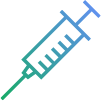Section 2 | Reading Livestock Medicines Labels
Page 08 /
Calculating Dosages
Drug Dosages
When we refer to the dosage of a drug, what we’re really talking about is:
- How much medicine to give at each time (the dose)
- How often to give it (number of doses)
- The interval between doses
For example, the dosage of penicillin for a sow could be 15 mL (the dose) once a day (interval between doses = 24 hours) for three days (number of doses = 3).
Manufacturers provide dosages that are proven to be safe and effective for the claims on the label. Dosage should be discussed with your veterinarian.
There are 5 key pieces of information that you need for giving the correct drug dosage:
- The dose of the drug (how much of the drug to give)
- The route of administration (how to give it to the animal)
- The dosing interval or frequency (how often to give the drug)
- Length of treatment (how many days to continue treatment)
- Withdrawal time (how long until it is safe to consume food products from the animal)
1. Calculating the Right Dose
There are four key questions you must answer to determine the right dose of a drug to give to an animal. Click each step below to read more and see an example:
-
Step 1 | What is the animal’s weight?
-
Step 2 | What is your drug concentration?
-
Step 3 | How much active drug do you need?
-
Step 4 | How much do you need?
2. Route of Administration
The label will clearly state how the drug should be given to the animal.
Routes of administration include:
- Injections: Intramuscular, intravenous, or subcutaneous
- Oral (e.g. direct administration, in feed, in water)
- Intramammary
- Topical
- Intrauterine
Many labels will also suggest the appropriate site of the body for injection. You should always use the recommended site and route of injection, unless otherwise advised by your veterinarian. This ensures that the medicine works as intended, has the least chance of causing adverse reactions in the animal, and/or illegal drug residues in the food products derived from that animal.
3. Dosing Interval
The label will tell you how often you should be giving the medicine. For example, you may need to give the medicine only once, one time per day, twice per day, or every few hours in a 24 hour period. The length of time between doses is the dosing interval.
4. Length of Treatment
The length of treatment, as outlined on the label or your prescription, should address the health concern. It should also be short enough to make sure that withdrawal times are not exceeded. Some drugs are long acting, and may only require one treatment. Other drugs may need multiple days of administration.
5. Withdrawal Time
The warning statement tells you how long until it is safe for humans to consume food products derived from the animal after treatment with a drug. Withdrawal times are based on our understanding of the way the drug is eliminated from the animal’s body. It is important to understand that any withdrawal time on the label is only correct if the drug is used exactly as directed on the label.
Any deviation from label instructions (e.g. too high a dose, more frequent dosing, and/or longer duration) and you can no longer confidently rely on the label’s withdrawal recommendations. If this is the case, you need to consult with your veterinarian for the appropriate withdrawal times.




